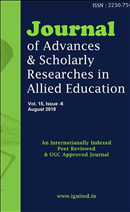A Brief Study of Girish Karnad’s Play Bali: The Sacrifice
Exploring Traditional Ideologies and Religious Conflict in Girish Karnad's Bali: The Sacrifice
Keywords:
Girish Karnad, Bali: The Sacrifice, Kannada, Hittina Hunja, Yashodhara Charite, ancient epic, violence, non-violence, Hinduism, JainismAbstract
It was first brought out into Kannada in 1980 by the name of Hittina Hunja. It has been taken from an ancient Kannada epic, Yashodhara Charite. Though the play is based on an ancient epic, yet it deals with the issues that are relevant today as they were many centuries ago. The plot of the play consists of four characters-The King, The Queen, The Queen Mother (the King’s Mother), The Mahout. The confrontation between the two traditional ideologies, violence and non-violence, associated with two religions namely Hinduism and Jainism are presented through the play. The Queen-Mother and the Queen are the representative perspectives of the ideologies. To present his idea, the dramatist has selected a royal family instead of a normal one because it is a centre which exerts influence on common people who just imitate the king and his culture and enlarged the scope of the play.Published
2018-08-05
How to Cite
[1]
“A Brief Study of Girish Karnad’s Play Bali: The Sacrifice: Exploring Traditional Ideologies and Religious Conflict in Girish Karnad’s Bali: The Sacrifice”, JASRAE, vol. 15, no. 6, pp. 509–511, Aug. 2018, Accessed: Dec. 25, 2025. [Online]. Available: https://ignited.in/index.php/jasrae/article/view/8562
Issue
Section
Articles
How to Cite
[1]
“A Brief Study of Girish Karnad’s Play Bali: The Sacrifice: Exploring Traditional Ideologies and Religious Conflict in Girish Karnad’s Bali: The Sacrifice”, JASRAE, vol. 15, no. 6, pp. 509–511, Aug. 2018, Accessed: Dec. 25, 2025. [Online]. Available: https://ignited.in/index.php/jasrae/article/view/8562











